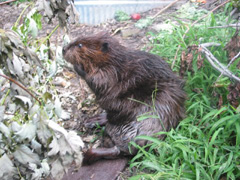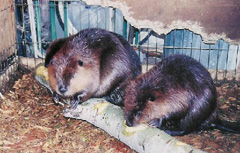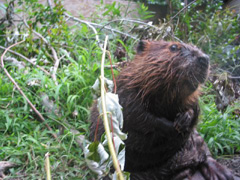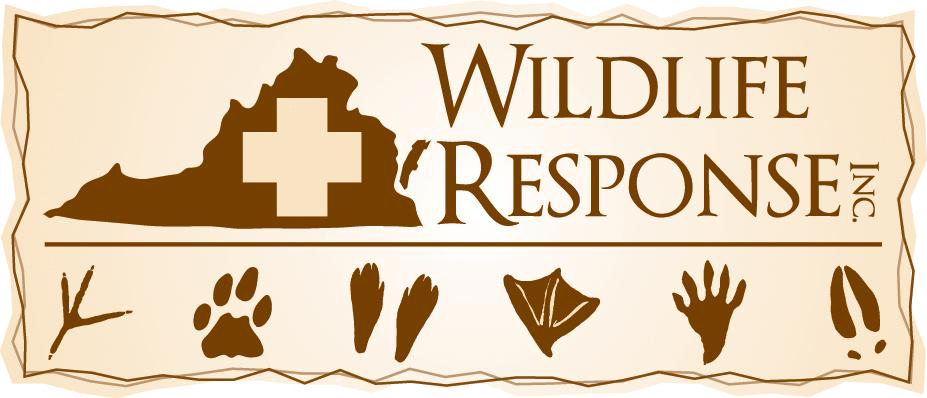(Castor Canadensis)
 In 940 A.D., the earliest written record of beavers appeared as a set of laws declaring beavers and other fur bearing mammals as property of the king. Popular folklore, both in Europe and North America, held that beavers provide an indication of the severity of the winter. If the beavers built up a large food cache, the winter would be severe. In Old English, the word for beaver was “beofor” which origin came from a word meaning brown. The scientific name “castor”, is the word for beaver in Latin. It means musk. The North American genus of beavers is “Canadensis”, a word referring to the Canadian territory. Based on existing fossil evidence, beavers most likely existed 37 million years ago. Beavers similar to today’s modern beaver evolved around 10,000 years ago. It was larger than today’s beaver and is believed to have weighed more than 400 pounds and was up to 8 feet long.
In 940 A.D., the earliest written record of beavers appeared as a set of laws declaring beavers and other fur bearing mammals as property of the king. Popular folklore, both in Europe and North America, held that beavers provide an indication of the severity of the winter. If the beavers built up a large food cache, the winter would be severe. In Old English, the word for beaver was “beofor” which origin came from a word meaning brown. The scientific name “castor”, is the word for beaver in Latin. It means musk. The North American genus of beavers is “Canadensis”, a word referring to the Canadian territory. Based on existing fossil evidence, beavers most likely existed 37 million years ago. Beavers similar to today’s modern beaver evolved around 10,000 years ago. It was larger than today’s beaver and is believed to have weighed more than 400 pounds and was up to 8 feet long.
The Lakota refer to Beaver spirit as Capa, the patron of work, food provisions and faithfulness. American Indians regard the beaver as a sacred animal. To harm a beaver was regarded as an omen of the visitation of evil upon their tribe. Indian legend told that man evolved from the beaver, which probably originated from the beaver’s construction skills.
A beaver’s body is built for its job as nature’s landscape designer. Its rounded body shape reduces water resistance. Its flat tail is relatively flexible and is used for counterbalance and as a rudder. The tail is almost hairless and is covered with tough, dark skin. The center of the tail is an extension of the spine. The tail is also used to slap the surface of the water as an alarm. Beavers will sit upright on their tail to groom with a special oil secreted from glands at the base of the tail, called castor glands. This oil will waterproof their fur. On land, the beaver usually drags its tail.
 A beaver’s eyes are small and its vision is not acute. Beavers are near sighted, but it is believed that they are able to see color. Beavers rely more on their senses of smell and hearing to protect themselves from predators. They have an “extra eyelid”, called a nictating membrane, that protects the eyes under water.
A beaver’s eyes are small and its vision is not acute. Beavers are near sighted, but it is believed that they are able to see color. Beavers rely more on their senses of smell and hearing to protect themselves from predators. They have an “extra eyelid”, called a nictating membrane, that protects the eyes under water.
A beaver’s nose has a special inner flap that seals out water when the beaver is submerged. Beavers have a special passage from their nose to their throat which connects to the upper lungs. This lets the beaver chew and breath through the its nose at the same time. Adult beavers can hold their breath under water for 15 minutes.
A beaver’s sense of smell is its most important sense, vital for finding food, identifying members of the colony, and detecting strangers and danger.
Beaver ears have inner flaps that seal out water when they are swimming. Their ears are small but their hearing is acute. They have oversized auditory canals, which allow them to pick up sounds and vibrations under water that may indicate danger.
A beaver’s teeth are well suited to their task of chewing through woody plant material. As with all rodents, the incisors are constantly growing. The incisors consist of two different materials. A hard orange enamel forms the cutting edge with a softer material beneath. Beavers sharpen their teeth by grinding them together.
Beavers are unique in the rodent family, as they are the only one to have five digits on each foot. The front feet are sensitive and dexterous. They can grasp branches or other objects with their paws because one their outside digits works like a thumb. The hind legs and feet are larger than the front. They are webbed, and not covered in fur. Both front and hind feet are clawed, and are used for digging. The hind feet have a double claw, which is used for grooming.
Male and female beavers are identical in looks and size. They have a thick coat of specialized hair and a layer of fat under the skin. The inner coat consists of extremely fine, soft hair that clings together because of tiny scales on the shafts. The long guard hairs are the only hair that molts. Fur color ranges from reddish brown to black.
Beavers weigh about a pound at birth. At one year, they will weigh between 10 and 15 pounds. By two years of age, they will weigh between 30 and 35 pounds. They do not reach maturity until the age of 4. Adults weights range from 45 to 60 pounds, with an occasional weight of 80 pounds. They live about 21 years. The oldest recorded age of a captive beaver was 50 years.
Beavers are monogamous, but will seek a new mate if theirs dies. A colony will consist of an adult pair, current offspring and the previous years offspring. The family is extremely close knit and very territorial. They are a matriarchal society. Beavers are generally nocturnal, and are most active in late afternoon into evening. Adult beaver are shy and quick to avoid danger.
Beavers live in fresh water. They prefer small lakes and slow moving streams. They typically swim at a speed of 2 mph, but are able to reach 6 mph if being chased. Adults are able to hold their breath for as long as fifteen minutes and can swim under water for up to one-half mile. A beaver’s heartbeat and circulation slow as it dives, a reflex it shares with whales, seals and porpoises.
 Beavers have few vocalizations. They rely primarily on subtle body postures and scent to communicate with other beavers. The kits are the most vocal. Whimpers and whines are their most common vocalizations, used to solicit attention and made when eating, grooming and playing. Grunting, whistling and nasal noises are made between colony members. Kits will make a loud whine when not getting their way. Grinding teeth is sometimes used as a warning. They will hiss and grunt before fighting or when frightened. A tail slap is used to warn the colony of danger. The female uses this the most. Colony members will swim to deeper water at this signal.
Beavers have few vocalizations. They rely primarily on subtle body postures and scent to communicate with other beavers. The kits are the most vocal. Whimpers and whines are their most common vocalizations, used to solicit attention and made when eating, grooming and playing. Grunting, whistling and nasal noises are made between colony members. Kits will make a loud whine when not getting their way. Grinding teeth is sometimes used as a warning. They will hiss and grunt before fighting or when frightened. A tail slap is used to warn the colony of danger. The female uses this the most. Colony members will swim to deeper water at this signal.
Beavers eat between two and five pounds of woody material daily. Beavers are fond of aspen, wild willow, maple, alder, birch, sweet gum, cottonwood, sweet bay and loblolly. Southern favorites include: dogwood, tupelo gum, sweet bay, juniper, pecan, elm, hornbeam, chinaberry, box elder, holly and wax myrtle.
They will sometimes eat field corn, soybeans, and alfalfa. They will eat rice grasses, ferns, berries and mushrooms. They are especially fond of water lilies, bulrushes, cattails, duck weed, pond weed, goldenrod and arrowhead. They also feed on the green scum that forms on a pond.
Many species benefit from the beaver’s construction activities. A variety of water fowl use beaver habitat. Reptiles increase in number and diversity, and populations of mink and otter will take advantage of the beaver‘s watery creation. Dammed streams make the land more fertile and stimulate the growth of vegetation. Dams are effective for drought control, regulating the slow flow of water downstream and backed up water helps to replenish the ground water supply. Dams also, filter the water that passes through them making the water downstream cleaner. (copied with permission from Wild At Heart)



